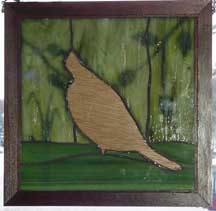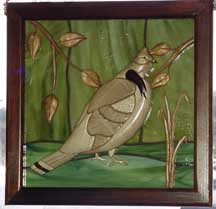 |
The art of Intarsia and the art of stained glass share certain basic characteristics which make them compatible with each other. Their use of small multicolored pieces to create a picture is similar. Background items such as sky, clouds, sun, moon, hills, and water features provide an excellent opportunity to incorporate color into your art. |
| Intarsia and stained glass can be combined to create truly beautiful art work designed to be displayed as windows, window hangings, or traditional wall hangings. |  |
| Narrow extensions of the Intarsia pattern such as branches, stems, legs, etc. are left off the backing board outline unless they can be incorporated to leave at least 1/2" of backing board width. Narrow Intarsia extensions are glued to the glass when the glass and backing board are fitted together. Note the shadows in the picture at right. |
 |
 |
The Intarsia is then glued into the glass opening. Small portions of the Intarsia that do not have backboards as mentioned above should be glued directly to the glass during this step. Avoid squeeze out when gluing to the front of the glass since this can be difficult to remove when dry. |
2/9/2000